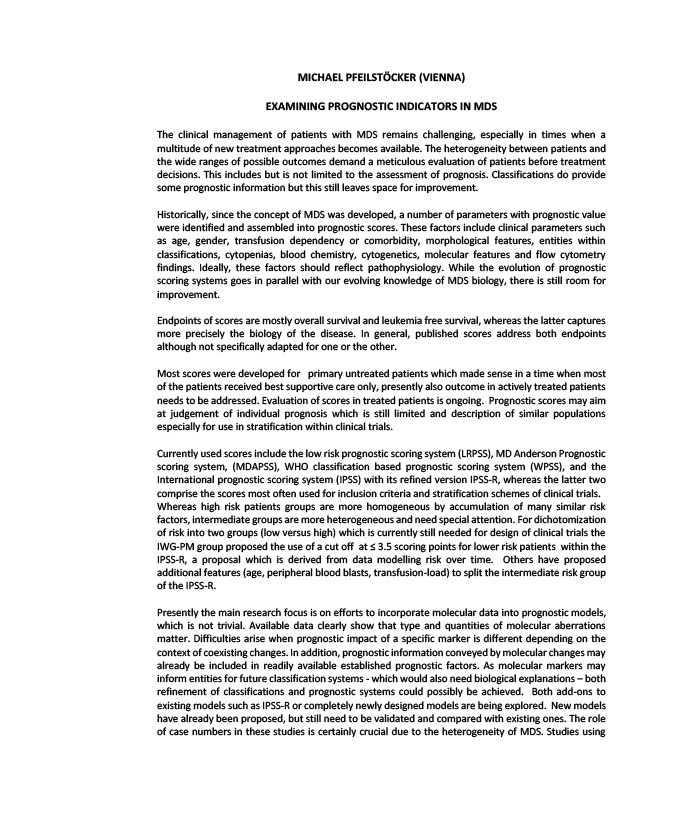
MICHAEL PFEILSTÖCKER (VIENNA)
EXAMINING PROGNOSTIC INDICATORS IN MDS
The clinical management of patients with MDS remains challenging, especially in times when a
multitude of new treatment approaches becomes available. The heterogeneity between patients and
the wide ranges of possible outcomes demand a meticulous evaluation of patients before treatment
decisions. This includes but is not limited to the assessment of prognosis. Classifications do provide
some prognostic information but this still leaves space for improvement.
Historically, since the concept of MDS was developed, a number of parameters with prognostic value
were identified and assembled into prognostic scores. These factors include clinical parameters such
as age, gender, transfusion dependency or comorbidity, morphological features, entities within
classifications, cytopenias, blood chemistry, cytogenetics, molecular features and flow cytometry
findings. Ideally, these factors should reflect pathophysiology. While the evolution of prognostic
scoring systems goes in parallel with our evolving knowledge of MDS biology, there is still room for
improvement.
Endpoints of scores are mostly overall survival and leukemia free survival, whereas the latter captures
more precisely the biology of the disease. In general, published scores address both endpoints
although not specifically adapted for one or the other.
Most scores were developed for primary untreated patients which made sense in a time when most
of the patients received best supportive care only, presently also outcome in actively treated patients
needs to be addressed. Evaluation of scores in treated patients is ongoing. Prognostic scores may aim
at judgement of individual prognosis which is still limited and description of similar populations
especially for use in stratification within clinical trials.
Currently used scores include the low risk prognostic scoring system (LRPSS), MD Anderson Prognostic
scoring system, (MDAPSS), WHO classification based prognostic scoring system (WPSS), and the
International prognostic scoring system (IPSS) with its refined version IPSS-R, whereas the latter two
comprise the scores most often used for inclusion criteria and stratification schemes of clinical trials.
Whereas high risk patients groups are more homogeneous by accumulation of many similar risk
factors, intermediate groups are more heterogeneous and need special attention. For dichotomization
of risk into two groups (low versus high) which is currently still needed for design of clinical trials the
IWG-PM group proposed the use of a cut off at ≤ 3.5 scoring points for lower risk patients within the
IPSS-R, a proposal which is derived from data modelling risk over time. Others have proposed
additional features (age, peripheral blood blasts, transfusion-load) to split the intermediate risk group
of the IPSS-R.
Presently the main research focus is on efforts to incorporate molecular data into prognostic models,
which is not trivial. Available data clearly show that type and quantities of molecular aberrations
matter. Difficulties arise when prognostic impact of a specific marker is different depending on the
context of coexisting changes. In addition, prognostic information conveyed by molecular changes may
already be included in readily available established prognostic factors. As molecular markers may
inform entities for future classification systems - which would also need biological explanations – both
refinement of classifications and prognostic systems could possibly be achieved. Both add-ons to
existing models such as IPSS-R or completely newly designed models are being explored. New models
have already been proposed, but still need to be validated and compared with existing ones. The role
of case numbers in these studies is certainly crucial due to the heterogeneity of MDS. Studies using